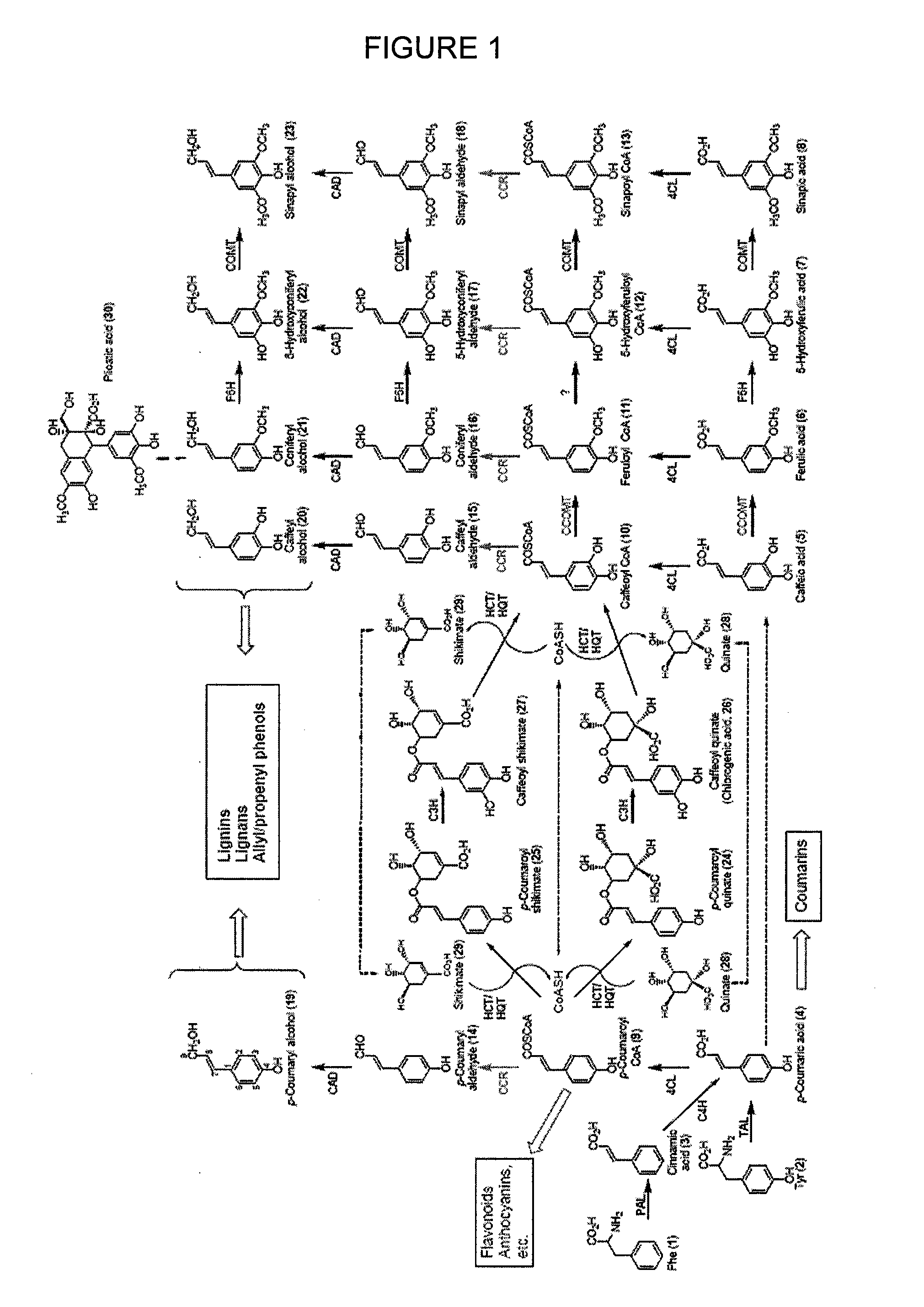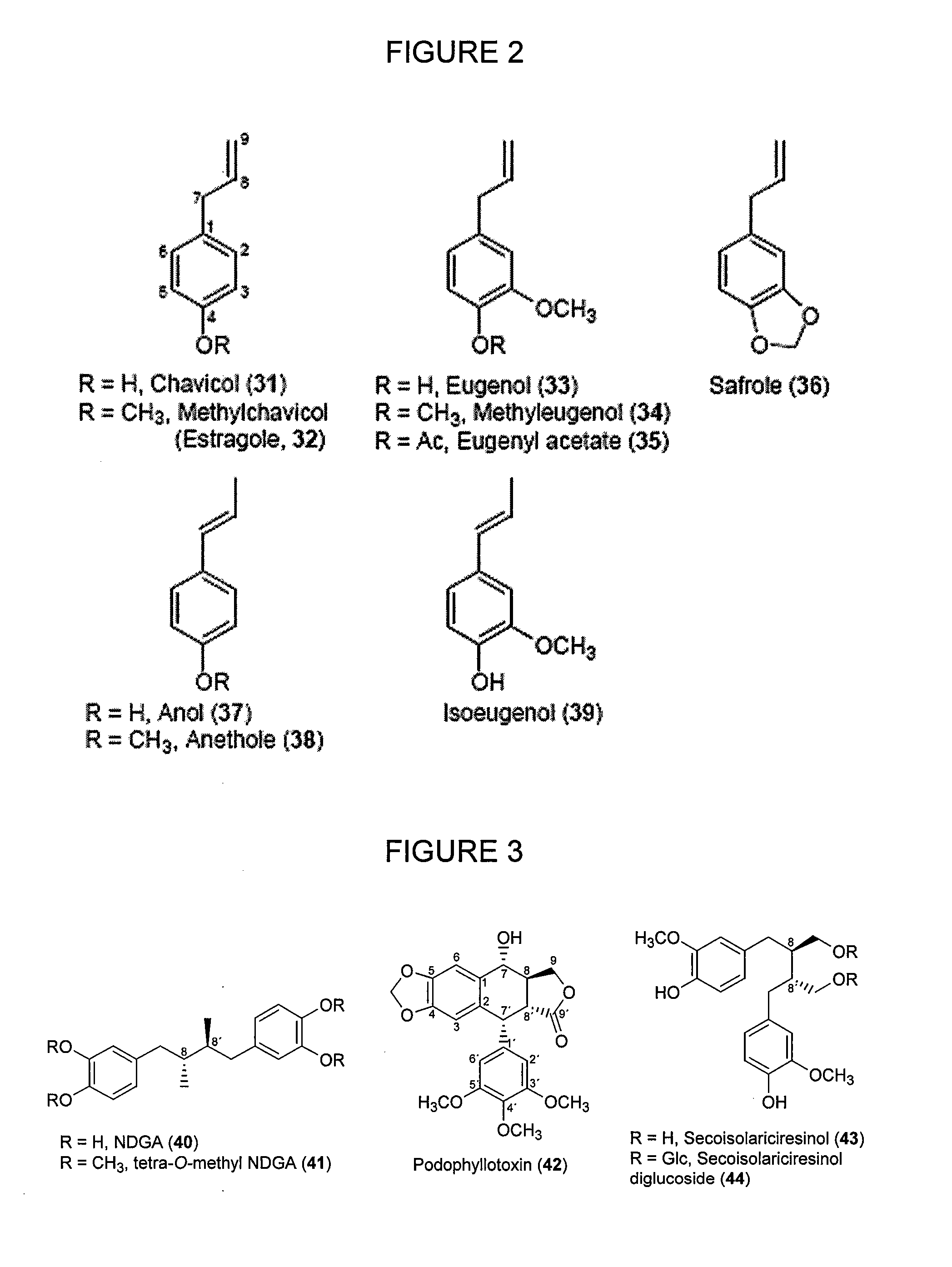Genes encoding chavicol/eugenol synthase from the creosote bush larrea tridentata
a technology of chavicol and eugenol, which is applied in the field of gene encoding chavicol/eugenol synthase from the creosote bush larrea tridentata, chavicol/eugenol formation or production, and can solve the problems of plant biomass utilization, huge political and scientific challenges, and unpredictable market prices
- Summary
- Abstract
- Description
- Claims
- Application Information
AI Technical Summary
Benefits of technology
Problems solved by technology
Method used
Image
Examples
example 1
(Novel Chavicol / Eugenol Synthases were Isolated from Larrea tridentata)
[0172]Example summary. The creosote bush (Larrea tridentata) accumulates a complex mixture of 8-8′ regiospecifically linked lignans, of which the potent antioxidant nordihydroguaiaretic acid (NDGA, 40) is the most abundant. Its tetra-O-methyl derivative (M4N, 41) is showing considerable promise in the treatment of the refractory (hard-to-treat) cancers of the head and neck. NDGA (40) and related 9,9′-deoxygenated lignans are thought to be formed by dimerization of allyl / propenyl phenols, phenylpropanoid compounds that lack C-9 oxygenation, thus differentiating them from the more common monolignol-derived lignans. In applicants' ongoing studies dedicated towards elucidating the biochemical pathway to NDGA (40) and its congeners, six pinoresinol-lariciresinol reductase homologues (“PLRh”) (SEQ ID NOS:2, 4, 6, 18, 20 and 22) were isolated from L. tridentata, with protein obtained in recombinant form. According to as...
example 2
Reaction Tissue Formation in Alfalfa, Medicago sativa L. (Fabaceae), Wild Type and p-Coumarate-3-Hydroxylase Down-Regulated Lines and their Stem Tensile Modulus Properties
[0240]Example summary. The discovery of reaction tissue in the forage crop alfalfa (Medicago sativa L.) is described, which to applicants knowledge, has not hitherto been established as occurring in herbaceous perennials. It was first observed during an investigation of a transgenic alfalfa line reduced in overall lignin content, but was also formed in the wild type line as well. The transgenic alfalfa line, obtained through standard down-regulation of the gene encoding p-coumarate-3-hydroxylase (pC3H), was reduced in lignin content by circa 64%, as expected from our previous metabolic flux analyses (Anterola et al., 2002). Comparison of the pC3H down-regulated (pC3H-I) and WT lines established several differences, however, when employing microscopy analyses and biomechanical testing of various (internodal) alfalfa...
example discussion
[0280]pC3H is involved in regulation of carbon flux into the G and S segments during macromolecular lignin assembly (Anterola and Lewis, 2002, Anterola et al., 2002). Reduction of pC3H activity would thus be expected to result in formation of a lignin-reduced phenotype, albeit largely derived from p-hydroxycinnamyl alcohol (H) moieties. This is because it is very well-documented that the H-phase of lignification precedes deposition of both G and S moieties (Fergus and Goring, 1970a, b; Whiting and Goring, 1982; Terashima and Fukushima, 1988; Fukushima and Terashima, 1991). Indeed, as expected, the net effect of down-regulating (or mutating) pC3H in A. thaliana results in a depleted lignin phenotype (˜64% lignin reduction relative to WT at maturation; Jourdes et al., 2007a) and largely containing H-units. However, this plant line was also severely dwarfed due to unknown ‘pleiotropic’ effects, and its vascular apparatus was greatly impaired (Jourdes et al., 2007a, see also Franke et a...
PUM
| Property | Measurement | Unit |
|---|---|---|
| Fraction | aaaaa | aaaaa |
| Fraction | aaaaa | aaaaa |
| Fraction | aaaaa | aaaaa |
Abstract
Description
Claims
Application Information
 Login to View More
Login to View More - R&D
- Intellectual Property
- Life Sciences
- Materials
- Tech Scout
- Unparalleled Data Quality
- Higher Quality Content
- 60% Fewer Hallucinations
Browse by: Latest US Patents, China's latest patents, Technical Efficacy Thesaurus, Application Domain, Technology Topic, Popular Technical Reports.
© 2025 PatSnap. All rights reserved.Legal|Privacy policy|Modern Slavery Act Transparency Statement|Sitemap|About US| Contact US: help@patsnap.com



